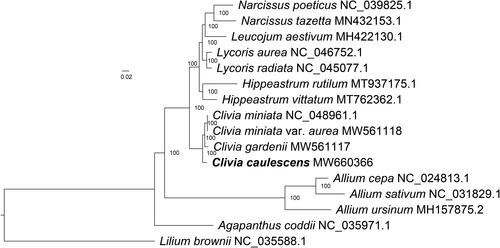Abstract
Clivia caulescens is an evergreen herbaceous flower with high ornamental value. In this study, we report its complete chloroplast genome sequence. The whole chloroplast genome was 158,149 bp in length, with a large single copy region (LSC, 86,250 bp), a small single copy region (SSC, 18,343 bp), and two inverted repeat regions (IRs, 26,778 bp). The overall GC content was 37.91%. There were 128 genes annotated, including 86 protein-coding genes, 34 tRNA genes, and eight rRNA genes. The phylogenetic tree showed that C. caulescens formed a monophyletic clade with C. miniata, C. miniata var. aurea, and C. gardenii.
Clivia caulescens R.A. Dyer 1943 belongs to the genus Clivia of Amaryllidaceae. As an evergreen herbaceous plant, C. caulescens is popular for its diverse colors, making it a prized ornamental. However, until now, the complete chloroplast genome sequence of C. caulescens has not been published. Herein, we report the complete chloroplast genome sequence of C. caulescens to provide a genomic resource and to clarify the phylogenetic relationship between C. caulescens and related taxa.
The sample of C. caulescens was collected from the Liaoning Academy of Agricultural Sciences (N41°48′33″, E123°34′53″), Shenyang, China. Total genomic DNA was isolated using a modified CTAB method (Doyle and Doyle Citation1987), and a specimen was deposited at the Institute of Floriculture of Liaoning Academy of Agricultural Sciences (contact person XH Zhao and email [email protected]) under the voucher number YJJZL04. The isolated genomic DNA was manufactured to create a shotgun library with an average of 400 bp, and sequenced on the Illumina NovaSeq platform with the 2 × 150 bp paired-end mode. The reads were then assembled by using GetOrganelle v1.6.2e (Jin et al. Citation2020) and annotated by the OGAP pipeline (https://github.com/zhangrengang/OGAP). The draft annotations were then adjusted manually.
The results showed that the complete chloroplast genome sequence of C. caulescens (GenBank accession No. MW660366) was a circular form with a typical four-segment of 158,149 bp in length, consisting of a large single-copy region (LSC, 86,250 bp), a small single-copy region (SSC, 18,343 bp), and two inverted repeat regions (IRs, 26,778 bp). The overall GC content of the genome was 37.91%. Additionally, the complete chloroplast genome of C. caulescens contained a total of 128 genes, including 86 protein-coding genes, 34 tRNA genes, and eight rRNA genes.
To better understand the phylogenetic relationship between C. caulescens and related species, the complete chloroplast genomes were downloaded from GenBank of 14 representative species of the family Amaryllidaceae, using Lilium brownii (Liliaceae) as an outgroup. Multiple alignment was carried out by MAFFT v7.471 software (Standley and Katoh Citation2013) and then trimmed with trimAl v1.2 (Capella-Gutiérrez et al. Citation2009). The phylogenetic tree was generated with IQ-TREE v1.6.5 (Nguyen et al. Citation2015), with the best-fit model of K3Pu + F+R3 and 1000 bootstrap replicates. The phylogenetic tree showed that C. caulescens, C. miniata, C. miniata var. aurea, and C. gardenii formed a monophyletic clade within Amaryllidaceae with 100% bootstrap values ().
Disclosure statement
No potential conflict of interest was declared by the author(s).
Data availability statement
The data that support the analyses and results of this study are openly available in GenBank with accession number MW660366 (http://www.ncbi.nlm.nih.gov/). The associated BioProject, SRA, and Bio-Sample numbers are PRJNA704718, SRR13781248, and SAMN18053627, respectively.
Additional information
Funding
References
- Capella-Gutiérrez S, Silla-Martínez JM, Gabaldón T. 2009. trimAl: a tool for automated alignment trimming in large-scale phylogenetic analyses. Bioinformatics. 25(15):1972–1973.
- Doyle JJ, Doyle JL. 1987. A rapid DNA isolation procedure from small quantity of fresh leaf material. Phytochem Bull. 119:11–15.
- Jin J-J, Yu W-B, Yang J-B, Song Y, dePamphilis CW, Yi T-S, Li D-Z. 2020. GetOrganelle: a fast and versatile toolkit for accurate de novo assembly of organelle genomes. Genome Biol. 21(1):241.
- Nguyen L-T, Schmidt HA, von Haeseler A, Minh BQ. 2015. IQ-TREE: a fast and effective stochastic algorithm for estimating maximum-likelihood phylogenies. Mol Biol Evol. 32(1):268–274.
- Standley DM, Katoh K. 2013. MAFFT multiple sequence alignment software version 7: improvements in performance and usability. Mol Biol Evol. 30(4):772–780.

